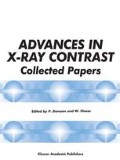Abstract
A little more than 60 years ago, a young American, Moses Swick, working in the department of the urologist von Lichtenberg in Berlin, used a mono-iodinated pyridine compound to perform an intravenous urogram [1]. Since then, there have been several generations of iodinated intravascular contrast agents, the latest being the low osmolality ionic and non-ionic types [2,3]. In spite of the development of new imaging techniques, the scale of use and, relevantly, the doses used in many examinations have tended to increase.
Access this chapter
Tax calculation will be finalised at checkout
Purchases are for personal use only
Preview
Unable to display preview. Download preview PDF.
References
Grainger RG. Intravascular contrast media-the past, the present and the future. Br J Radiol. 1982; 55: 1–18.
Dawson P, Grainger RG, Pitfield J. The new low osmolality contrast agents. A simple guide. Clin Radiol. 1983; 34: 221–226.
Dawson P. Chemotoxicity of contrast media and clinical adverse effects: a review. Invest Radiol. 1985; 20: 52–59.
Macewan DW, Dunbar JS, Nogrady MB. Intravenous pyelography in children with renal insufficiency. Radiology. 1962; 78: 893–903.
Schwartz RH, Hurwitt A, Ettinger A. Intravenous urography in the patient with renal insufficiency. N Engl J Med. 1963; 269: 277–283.
Gup AD, Fischman JL, Aldridge G, Schlegal JK. The effect of drip in infusion pyelography on renal function. Am J Roentgenol. 1966; 98: 102–106.
Bengtsson U, Cederbom G, Falkheden T, Jagenburg R. Can J Urol Nephrol. 1968; 2: 173–176.
Fry IK, Cattell WR. Excretion urography in advanced renal failure. Br J Radiol. 1971; 44: 198–202.
Davidson AJ, Becker J, Rothfield N, Unger G, Ploch DR. An evaluation of the effect of high dose urography on previously impaired renal and hepatic function in man. Radiology. 1970; 97: 249–254.
Eisenberg RL, Bank WO, Hedgcock MW. Renal failure after major angiography. Am J Med. 1980; 68: 43–46.
Carvallo A, Rakolwski TA, Argy WP, Schreiner GE. Acute renal failure following drip infusion pyelography. Am J Med. 1978; 65: 38–45.
D’Elia JA, Gleason RE, Aldy M. Nephrotoxicity from angiographic contrast material. A prospective study. Am J Med. 1982; 72: 719–725.
Byrd L, Sherman SY. Radiocontrast-induced acute renal failure: A clinical and pathophysiologic review. Medicine. 1979; 58: 270–279.
Older RA, Korobkin M, Cleeve DM, Schaaf R, Thompson W. Contrast-induced acute renal failure: Persistent nephrogram as clue to early detection. Am J Roentgenol. 1980; 134: 339–342.
Rao SR, Miexa A, Leiter E. Renal failure in diabetes after intravenous urography. Urology. 1980; 15: 577–580.
Dawson P. Contrast agent nephrotoxicity: an appraisal. Br J Radiol. 1985; 58: 121–124.
Trewhella M, Forsling M, Richards D, Dawson P. Dehydration, antidiuretic hormone and the intravenous urogram. Br J Radiol. 1987; 60: 445–447.
Trewhella M, Dawson P, Forsling M, McCarthy P, O’Donnell C. Vasopressin release in response to intravenously injected contrast media. Br J Radiol. 1990; 63: 97–100.
Whitehouse RW. High-and low-osmolar contrast agents in urography. A comparison of the appearances with respect to pyelotubular opacification and renal length. Clin Radiol. 1986; 37: 395–398.
Sjöberg S, Almen T, Golman K. Excretion of urographic contrast media. Iohexol and other media during free urine flow in the rabbit. Acta Radiol. 1980; 362(Suppl): 93–98.
Katzberg RW, Morris TM, Lasser EC, et al. Acute systemic and renal hemodynamic effects of meglumine/sodium diatrizoate 76% and iopamidol in euvolemic and dehydrated dogs. Invest Radiol. 1983; 21: 793–797.
Törnquist C. Nephrotoxicity of ionic and non-ionic contrast media in experimental and clinical nephroangiography. With special reference to ionic diatrizoate and metrizoate and non-ionic iohexol. 1985. Thesis, University of Lund.
Love L, Lind JR, Olson MC. Persistent CT nephrogram: significant in the diagnosis of contrast nephropathy. Radiology. 1989; 172: 125–129.
Love L. 1993. Private communication.
Holtas S. Proteinuria following nephroangiography. 1978. Thesis, Malmo General Hospital, Malmo, Sweden.
Thomsen HS, Dorph S, Mygind T, et al. Intravenous injection of ioxilan, iohexol and diatrizoate. Effects on urine profiles in the rat. Acta Radiol. 1988; 29: 131–136.
Thomsen HS, Hemmingsen L, Dorph S, Skaarup P. Effects on urine profiles of idatrizoate in hydrated and dehydrated rats. A double cross-over study. Acta Radiol. 1988; 29: 731–735.
Goldstein EJ, Feinfield DA, Fleischner CM, Elkin M. Enzymatic evidence of renal tubular damage following renal angiography. Radiology. 1976; 121: 617–619.
Moreau JF, Droz D, Noel LH, Heibowitch J, Ungers P, Michel JR. Tubular nephrotoxicity of water soluble iodinated contrast media. Invest Radiol. 1980; 15: S54–S60.
Thomsen HS, Golman K, Hemmingsen L, Skaarup P, Svendsen O. Contrast medium induced nephropathy animal experiments. Front Eur Radiol. 1993; 9: 87–107.
Vaamonde CA, Bier RT, Papendick R, Alpert H, Gouvea W, Owens B, et al. Acute and chronic renal effects of radiocontrast in diabetic rats. Role of anaesthesia and risk factors. Invest Radiol. 1989; 24: 210–218.
Katzberg RW. What do we really know about contrast medium-induced acute renal failure? Invest Radiol. 1989; 24: 219–220.
Parfrey PS, Griffiths SM, Barrett B J, Paul MD, Genge M, et al. Contrast material induced renal failure in patients with diabetes mellitus, renal insufficiency, or both. N Engl J Med. 1989; 320: 143–149.
Schwab SJ, Hlatky MA, Pieper KS, Davidson CJ, Morris KG, Stelton TN, et al. Contrast nephrotoxicity: a randomized controlled trial of a non-ionic and an ionic radiographic contrast agent. N Engl J Med. 1989; 320:149–153.
Gomes AS, Lois JF, Baker JD, McGlade CT, Bunnell DH, Hartzman S. Acute renal dysfunction in high-risk patients after angiography: Comparison of ionic and non-ionic contrast media. Radiology. 1989; 170: 65–68.
Katholi RE, Taylor GJ, Woods WT, et al. Nephrotoxicity of non-ionic low-osmolality versus ionic high osmolality contrast media: a prospective double blind randomized comparison in human beings. Radiology. 1993; 186:183–187.
Author information
Authors and Affiliations
Editor information
Editors and Affiliations
Rights and permissions
Copyright information
© 1998 Springer Science+Business Media Dordrecht
About this chapter
Cite this chapter
Dawson, P. (1998). On the nephrotic potential of the iodinated intravascular agents. In: Dawson, P., Clauss, W. (eds) Advances in X-Ray Contrast. Springer, Dordrecht. https://doi.org/10.1007/978-94-011-3959-5_1
Download citation
DOI: https://doi.org/10.1007/978-94-011-3959-5_1
Publisher Name: Springer, Dordrecht
Print ISBN: 978-0-7923-8741-1
Online ISBN: 978-94-011-3959-5
eBook Packages: Springer Book Archive

